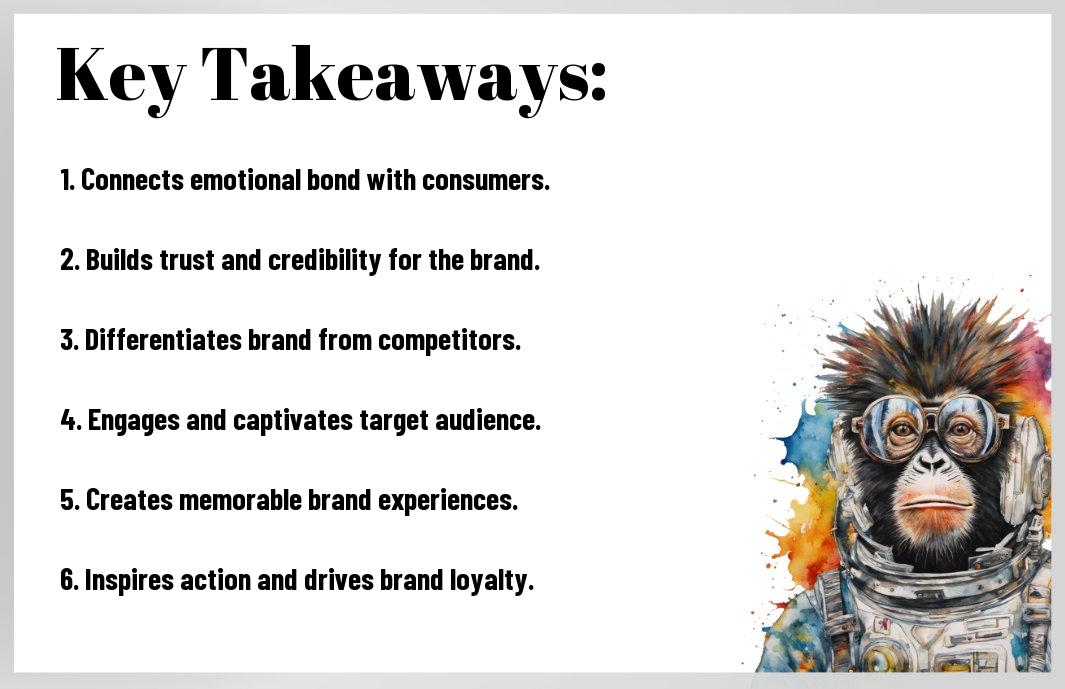The Importance Of Storytelling In Brand Strategy
Many successful brands understand the power of storytelling in shaping their brand identity and connecting with their audience on a deeper level. Strategic storytelling can help companies differentiate themselves in a crowded market, evoke emotions, and create a lasting impression in consumers’ minds. This blog post will explore the significance of storytelling in brand strategy, discuss how it can influence consumer perception and behavior, and provide tips on how to effectively incorporate storytelling into your brand’s marketing efforts.
Key Takeaways:
- Storytelling is a powerful tool: Incorporating storytelling into brand strategy can create emotional connections with consumers and build a memorable brand image.
- Authenticity is key: It is important for brands to tell authentic stories that resonate with their values and connect with their target audience on a deeper level.
- Establishes brand identity: Storytelling helps define a brand’s personality, values, and mission, helping consumers understand what the brand stands for.
- Engages consumers: Compelling storytelling can capture the attention of consumers, keeping them engaged with the brand and encouraging brand loyalty.
- Differentiates from competitors: Brands that tell unique stories can stand out in a crowded marketplace and differentiate themselves from competitors.
- Creates shareable content: Stories have the power to be shared across various platforms, increasing brand visibility and reaching a wider audience.
- Drives emotional connections: Emotional storytelling can evoke strong feelings in consumers, leading to a deeper connection with the brand and potentially driving purchase intent.


The Role of Storytelling in Brand Building
Creating an Emotional Connection
Some of the most powerful brands in the world have one thing in common – they are able to create a deep emotional connection with their audience. Storytelling is the key to unlocking this emotional bond, as it allows brands to communicate their values, beliefs, and purpose in a way that resonates with consumers on a personal level.
Establishing Brand Identity and Values
Emotional storytelling is also crucial in establishing a brand’s identity and values. By crafting a compelling brand narrative, companies can differentiate themselves from competitors and communicate what they stand for. This helps build trust and loyalty among consumers who share the same values.
This emotional connection can have a significant impact on consumer purchasing decisions and brand loyalty in the long run. When consumers feel connected to a brand on an emotional level, they are more likely to become repeat customers and advocate for the brand to others.
The Mechanics of Effective Storytelling
Narrative Structure in Brand Messaging
All successful brand stories have a narrative structure that engages the audience from beginning to end. This structure typically includes a clear beginning, where the brand establishes its identity and sets the tone for the story; a middle section where challenges are presented, and the brand’s values are put to the test; and an ending that delivers a resolution or call to action that leaves a lasting impression on the audience.
Techniques for Engaging the Audience
One of the key techniques for engaging the audience is to create relatable characters or situations that resonate with them on a personal level. This can be achieved through emotive storytelling, using language and imagery that evokes strong emotions and makes the audience feel connected to the brand. Another effective technique is to use a mix of media formats such as videos, podcasts, and social media posts to reach a wider audience and keep them engaged across different platforms.
For instance, incorporating interactive elements like polls, quizzes, or live streams can encourage audience participation and create a sense of community around the brand. This not only boosts engagement but also helps in gathering valuable feedback and insights from customers that can be used to tailor future brand messaging and storytelling efforts.
Integration of Storytelling Across Platforms
Consistency in Multi-Channel Marketing
The key to successful storytelling in brand strategy lies in maintaining consistency across all platforms. Consistency in messaging, tone, and visual elements helps create a unified brand identity that resonates with consumers. Whether it is social media, email marketing, or traditional advertising, ensuring a consistent brand story enhances brand recall and fosters trust among the target audience.
Leveraging Digital Media for Brand Narratives
The digital landscape provides brands with a multitude of opportunities to craft compelling narratives. By leveraging digital media such as websites, blogs, social media, and video content, brands can engage with their audience on a more personal level. These platforms offer the flexibility to experiment with different storytelling formats and create immersive brand experiences that resonate with consumers.
Across various digital platforms, brands can utilize interactive features, user-generated content, and personalized messaging to enhance brand storytelling. By incorporating these elements strategically, brands can create meaningful connections with their audience and differentiate themselves in a crowded marketplace.
Measuring the Impact of Storytelling on Brand Success
Key Performance Indicators for Storytelling
Impact Your brand’s storytelling success can be measured through various Key Performance Indicators (KPIs) such as brand awareness, customer engagement, website traffic, and conversion rates. These indicators help you track the effectiveness of your storytelling strategy and its impact on your brand’s success.
Analyzing Customer Engagement and ROI
An effective way to measure the impact of storytelling on brand success is by analyzing customer engagement metrics such as likes, comments, shares, and click-through rates. These metrics provide insights into how well your brand’s stories are resonating with your target audience and driving them to take action, ultimately leading to a positive Return on Investment (ROI).
Brand Be mindful of, storytelling is not just about crafting compelling narratives; it’s about building a strong emotional connection with your audience. By measuring KPIs and analyzing customer engagement metrics, you can gain valuable insights into the effectiveness of your brand’s storytelling efforts and make data-driven decisions to continuously improve your brand strategy.
To wrap up
With these considerations in mind, it is clear that storytelling plays a crucial role in brand strategy. By creating a compelling narrative that resonates with consumers, brands can establish emotional connections, differentiate themselves from competitors, and build long-lasting relationships. Through storytelling, brands can communicate their values, mission, and vision in a way that captivates and engages audiences. Ultimately, storytelling humanizes a brand, making it more relatable and memorable in the minds of consumers. As such, incorporating storytelling into brand strategy is not just a trend, but a fundamental tool for success in a competitive market.
FAQ
Q: Why is storytelling important in brand strategy?
A: Storytelling helps create an emotional connection with customers, differentiates a brand from its competitors, and makes the brand more memorable.
Q: How does storytelling impact consumer behavior?
A: Stories appeal to our emotions and values, influencing how we perceive a brand and ultimately affecting our purchasing decisions.
Q: What elements make a good brand story?
A: A compelling brand story should be authentic, relevant to the brand and its audience, and evoke emotions that resonate with consumers.
Q: How can storytelling be integrated into brand strategy?
A: Storytelling can be incorporated into brand strategy through brand messaging, content marketing, advertising campaigns, and social media engagement.
Q: Can storytelling help build brand loyalty?
A: Yes, storytelling helps create a loyal customer base by fostering trust, strengthening brand identity, and providing a consistent narrative that consumers can relate to.
Q: How can small businesses leverage storytelling in their branding?
A: Small businesses can use storytelling to humanize their brand, communicate their values, and stand out in a crowded marketplace, thus attracting and retaining customers.
Q: What are some successful examples of brands using storytelling in their strategies?
A: Brands like Nike, Apple, and Coca-Cola are known for their powerful brand stories that have helped them connect with audiences on a deeper level and establish a strong brand presence in the market.







